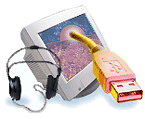|
 The Plug and Play
support in Windows 98 is a lot like the simple things in
life we take for granted. You
turn on a faucet and expect a gush of water. Plug in your guitar
and prepare for sonic joy—and noise complaints from the neighbors. Plug in a
toaster and—well, you get the idea. The Plug and Play
support in Windows 98 is a lot like the simple things in
life we take for granted. You
turn on a faucet and expect a gush of water. Plug in your guitar
and prepare for sonic joy—and noise complaints from the neighbors. Plug in a
toaster and—well, you get the idea.
Windows 98 supports the latest hardware standards, and provides device support
for both existing and new generation computers. More importantly, it
eliminates guesswork by automatically configuring installed hardware
and loading the appropriate drivers.
Here are a few of the Plug and Play features you can take for
granted in Windows 98.
Universal
Serial Bus (USB)
USB provides a
single port that lets you connect and disconnect a wide array of
external peripheral device—such as scanners and camcorders—without
configuring or rebooting your desktop or laptop. USB also supports
interactive devices such as joysticks and isochronous devices such
as telephony, audio, and imaging devices.
What this means
to you: Plug and play is a real concept. Devices are
good-to-go. Simple pleasures.
Read more about USB support in Windows 98 here.
IEEE
1394
IEEE 1394 is a high-speed serial bus
standard that complements USB and provides a higher-bandwidth
connection for devices that require faster data transfer. It can
support data transfer rates of up to 400 million bits per second.
IEEE 1394 also delivers data at a guaranteed rate, making it ideal
for a wide range of devices that need to transfer high levels of
data in real-time, including digital video cameras, printers,
scanners, computers, and hand-held devices.
What this
means to you:
More digital devices. More work gets done—with less hassle. More
time to play—and more to play with.
Infrared Data Association (IrDA)
support
IrDA
is an infrared protocol that provides secure, wireless
communications between two Windows 98-based computers or devices that are using
it. If your laptop computer and printer have IrDA ports, you can
place them opposite one another, then print a document from the
laptop without any cable connections. IrDA hardware is deployed in a
large number of new notebook computers, but until recently, the
hardware has not been available for applications programmers to use
because of a lack of suitable protocol drivers. Windows98 supports
IrDA, including IrDA programming APIs that enable file sharing
applications and games.
What this means to you: No more mismatched connectors and wiring. Speed
and configuration parameters are transparent. Better application programming.
Accelerated Graphics Port
(AGP)
Windows 98 lets
you work with high-quality graphics by supporting
new display devices such as Accelerated Graphics Port (AGP),
multiple video cards and monitors, OpenGL 1.2, DirectX® 7.0 API,
and Video Port Extensions. Rather than using the Peripheral Component Interconnect
(PCI) bus for graphics data, AGP provides a dedicated, high-speed port
through which large blocks of 3D data can be transferred between the
computer's graphics controller and system memory.
What
this means to you: Frees up memory on your computer. Twice
as fast as a normal PCI card. Every picture tells a story.
So, if you
splurged for a new scanner in your office, or
a digital camera or video recorder in
your home, just plug it in and let it
rock. Simple pleasures, indeed. If only programming the VCR were so easy.


Michael Raymond is still trying to plug his toaster into his computer.
|
To Install a Plug and Play Device:
1. Turn
off your computer.
2. Connect the device to your computer
according to the manufacturer's instructions.
3. Turn on your
computer and start Windows. Windows will automatically detect the
new Plug and Play device and install the necessary software.
Having installation problems?
Try Microsoft
Support's Windows
98 Hardware Troubleshooting Page,
which links to various hardware troubleshooting resources.
For a broad
range of support information, visit: FAQs
& Highlights for Windows 98.
Too much technospeak?
The Microsoft Developer
Network’s hardware
glossary can help with the terminology.
|
